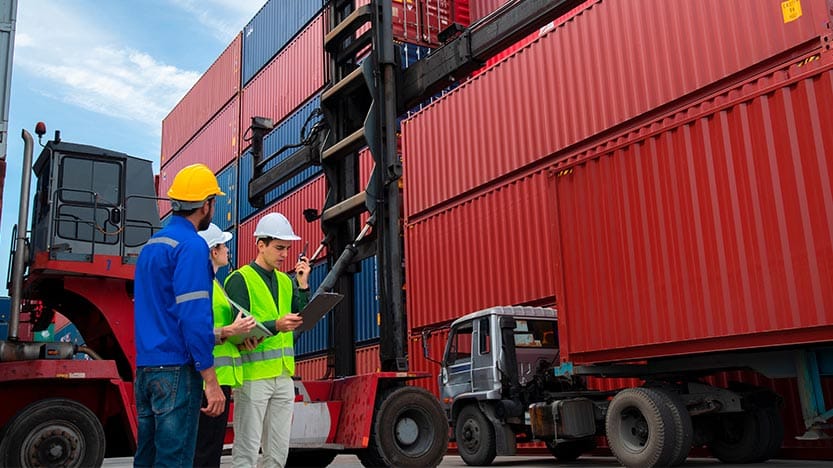Freight shipping is vital to global commerce, allowing businesses to transport goods and products across vast distances efficiently and cost-effectively. However, the world of freight shipping can be complex, particularly when determining the appropriate shipping class for your cargo.
This comprehensive guide will explore shipping classes for freight, their significance, and how to determine the right class for your shipments.
Table of Contents
- What are the Different Freight Classes?
- What are the different freight shipping classes?
- Freight class chart
- How are freight classes for shipping determined?
- Steps to determine shipping classes for freight
- Tips for Properly Classifying Your Freight
- Factors Affecting Freight Shipping Classes
- How do freight classes for shipping affect shipping costs?
- Benefits of Understanding Freight Shipping Classes
- How SFL Worldwide Can Help You Manage Freight Shipping Classes
- Conclusion
What are the Different Freight Classes?
Freight shipping classes are a standardized system used to categorize different types of products being shipped. The National Motor Freight Traffic Association (NMFTA) developed the system to ensure that all freight shipments are classified and priced fairly.
There are 18 classes, ranging from Class 50 (the least dense and most lightweight) to Class 500 (the most dense and heaviest). The class of your shipment will determine the shipping cost, so it’s important to understand how it’s calculated and what factors are considered.
What are the different freight shipping classes?
There are 18 different freight classes for shipping, ranging from class 50 to class 500. Class 50 is the lowest and least expensive, while class 500 is the highest and most expensive. The class is determined based on the four factors of density, stability, handling, and liability, with higher classes indicating a higher level of difficulty in shipping and handling the product. It’s important to understand the class of your shipment to ensure that you are paying the appropriate shipping costs and that your product is being handled and transported safely.
Freight class chart
The following chart provides a detailed breakdown of freight classes and corresponding weight ranges per cubic foot, helping businesses accurately classify and estimate shipping costs based on their cargo’s characteristics and referring to this comprehensive chart to determine the appropriate freight class and understand the weight parameters associated with each class for efficient logistics management.
Please note that these weight ranges per cubic foot are approximate and can vary depending on the specific characteristics of the freight. It’s important to consult the official NMFC guidelines or contact your chosen carrier for precise weight requirements for each class.
How are freight classes for shipping determined?
Shipping classes for freight are determined based on four factors: density, stability, handling, and liability. Density refers to the product’s weight per cubic foot, while stability considers how easily the product can be stored and transported.
Handling refers to the level of care required to handle the product, and liability takes into account the likelihood of the product causing damage or injury. These factors are combined to determine the appropriate class for the shipment.

Steps to determine shipping classes for freight
To determine the appropriate shipping class for your freight, you will need to follow these steps:
Measure and Weigh
Measure the dimensions of your freight, including length, width, and height. Then, weigh the cargo to determine its actual weight.
Calculate Density
To calculate the density, divide the weight of the freight by its volume (length x width x height). The result will be the density of your cargo.
Refer to NMFC Guidelines
Consult the NMFC guidelines to identify the appropriate shipping class based on your freight’s density and other characteristics. The NMFC provides a comprehensive list of commodities and their corresponding classes.
Confirm with the Carrier
Double-check the shipping class with your chosen carrier to ensure compliance with their specific classification guidelines. Carriers may have rules and regulations that align with the NMFC but could have additional considerations.
Get Quote and Save UPTO 70% on your next shipping
Tips for Properly Classifying Your Freight
Properly classifying your freight is crucial to ensuring that you pay the correct shipping costs and avoid any unexpected fees or delays. Here are some tips to help you accurately determine the class of your shipment:
- Understand how the National Motor Freight Classification (NMFC) system works.
- Carefully measure and weigh your shipment to determine its density.
- Consider your product’s fragility, handling requirements, and liability.
- Consult with a freight expert or carrier representative if you need clarification on the classification of your shipment.
- Regularly review and update the classification of your products to ensure accuracy and avoid any potential issues.
Factors Affecting Freight Shipping Classes
Several factors are considered when determining the appropriate shipping class for a particular type of freight. These factors include:
Density
The density of the cargo refers to how much space it occupies per unit of weight. Freight with a higher density is assigned a lower shipping class since it takes up less space about its weight.
Stowability
Storability measures how well the freight can be stored and stacked in a carrier’s transport vehicle. Freight that is difficult to store or handle may be assigned a higher shipping class.
Handling
This factor considers the ease or difficulty of loading and unloading the freight. Freight that requires special equipment or careful handling may be classified as a higher class.
Liability
Liability refers to the likelihood of the freight causing damage to other cargo or the carrier’s equipment. Freight with a higher risk of damage may be assigned a higher shipping class.
Special Requirements
Suppose the freight has specific requirements for transportation, such as temperature control or hazardous materials handling. In that case, it may be assigned a higher shipping class due to the additional care and precautions needed.
How do freight classes for shipping affect shipping costs?
Freight shipping classes have a direct impact on shipping costs. The higher the class of your shipment, the more expensive it will be to ship. Higher classes indicate that the product is more difficult to handle and transport, which requires more resources and specialized equipment.
Higher classes may also indicate a higher level of liability, which can increase insurance costs. It’s important to accurately determine the class of your shipment to ensure that you are paying the appropriate shipping costs and avoiding any unexpected fees or delays.
Benefits of Understanding Freight Shipping Classes
Understanding freight classes for shipping can bring several advantages to your business:
Accurate Cost Estimation
You can estimate the shipping costs more accurately by correctly determining the shipping class. This helps you budget effectively and avoid unexpected expenses.
Efficient Carrier Selection
Knowledge of shipping classes allows you to select carriers that specialize in handling your specific type of freight. This ensures that your cargo is handled properly and reaches its destination on time.
Optimal Packaging
Different shipping classes may require specific packaging requirements and follow the general guidelines. Understanding the appropriate shipping class enables you to package your freight correctly, minimizing the risk of damage during transit.
Negotiating Shipping Rates
When you clearly understand freight shipping classes, you are in a better position to negotiate shipping rates with carriers. With knowledge about the classification system and the class assigned to your cargo, you can engage in more informed discussions and potentially secure more favorable pricing.
Avoiding Penalties and Delays
Labeling your freight can lead to penalties and delays. If your cargo is assigned a lower shipping class than it should be, carriers may impose additional charges or refuse to transport the shipment. On the other hand, if your freight is assigned a higher shipping class, you may pay more than necessary. By understanding freight classes for shipping, you can ensure accurate classification and avoid costly mistakes.
Compliance with Regulations
Certain types of freight, such as hazardous materials, have specific regulations and requirements. Understanding the shipping class and associated regulations helps you comply with legal and safety standards. It ensures your freight is properly labeled, packaged, and handled according to the applicable guidelines.
Streamlining Supply Chain Operations
Efficient supply chain management relies on accurate classification and handling of freight. Understanding shipping classes for freight allows you to align your logistics processes, warehouse operations, and transportation strategies accordingly. Streamlining these operations can improve overall efficiency, reduce transit times, and enhance customer satisfaction.
How SFL Worldwide Can Help You Manage Freight Shipping Classes
SFL Worldwide is a leading freight shipping and logistics provider that can assist businesses in managing freight shipping classes effectively. Here’s how you can work with SFL Worldwide to navigate freight classes for shipping:
Expert Guidance
SFL Worldwide has a team of experienced professionals well-versed in the intricacies of shipping classes for freight. They can provide expert guidance and support in determining the appropriate shipping class for your cargo. Whether you are shipping heavy machinery, fragile items, or oversized goods, their team can help you navigate the classification process.
Accurate Classification
SFL Worldwide ensures that your cargo is accurately classified according to the National Motor Freight Classification (NMFC) system. By understanding the density, stability, handling requirements, and other factors of your freight, they can assign the correct shipping class, ensuring compliance and minimizing the risk of penalties or delays.
Cost Optimization
With extensive knowledge of freight shipping classes, SFL Worldwide can help you optimize shipping costs. By selecting the most appropriate shipping class based on your cargo’s characteristics, they can provide cost-effective solutions without compromising on the quality of service. Their expertise allows them to negotiate favorable rates with carriers, ensuring you receive competitive shipment pricing.
Customized Solutions
SFL Worldwide recognizes that every business has unique shipping requirements. They offer customized solutions tailored to your specific needs. Whether you require expedited shipping, specialized handling, or assistance with packaging and documentation, SFL Worldwide can accommodate your requirements and provide personalized solutions that align with your freight’s shipping class.
Transparent Communication
Effective communication is crucial in managing shipping classes for freight. SFL Worldwide maintains transparent and open lines of communication throughout the shipping process. They keep you informed about the classification, rates, and any updates related to your shipments. Their customer support team is readily available to address any queries or concerns regarding freight shipping classes.
Efficient Logistics Management
SFL Worldwide’s comprehensive logistics management capabilities ensure your shipments are handled seamlessly from origin to destination. They coordinate all aspects of the shipping process, including pickup, transportation, documentation, and customs clearance. By managing the intricacies of the logistics, they ensure your freight is handled by its assigned shipping class, minimizing risks and ensuring timely delivery.
Get Quote and Save UPTO 70% on your next shipping
Conclusion
Freight shipping classes play a crucial role in determining the rates and handling practices for different types of cargo. Understanding the classification system enables businesses to make informed decisions, estimate shipping costs accurately, and select appropriate carriers.
Following the steps outlined in this comprehensive guide, you can determine the correct shipping class for your freight and ensure compliance with regulations. Moreover, knowing freight classes for shipping empowers you to negotiate better rates, minimize delays and penalties, and optimize your supply chain operations.

SFL Worldwide is a top global logistics company delivering services in transportation, relocation, and freight forwarding. Since 2005, The company has handled domestic and international shipments. SFL helps its customers navigate through the complicated shipping regulations and documentation by providing professional advice. The company uses its network of 200+ partners to provide effective solutions to individuals and businesses. Its knowledge and experience give customers the assurance of safe, quick, and reliable global delivery, along with tracking available 24/7. Its ability to handle over 100,000 successful relocations worldwide is testimony to its reliability.



